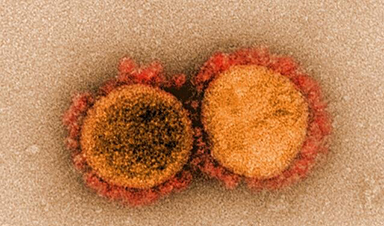Scientists at The University of Texas MD Anderson Cancer Center and Northwestern Medicine have identified natural extracellular vesicles containing the ACE2 protein (evACE2) in the blood of COVID-19 patients that can block infection from broad strains of SARS-CoV-2 virus in preclinical studies. The study was published today in Nature Communications.
The study is the first to show evACE2 are capable of fighting the new SARS-CoV-2 variants with an equal or better efficacy than blocking the original strain. The researchers found that evACE2 exist in human blood as a natural anti-viral response. The more severe, the higher the levels of evACE2 detected in the patient’s blood.
“Whenever a new mutant strain of SARS-CoV-2 surges, the original vaccine and therapeutic antibodies may lose power against alpha, beta, delta and the most recent, omicron,” said co-senior author Huiping Liu, M.D., Ph.D., associate professor of pharmacology and medicine at Northwestern University Feinberg School of Medicine. “However, the beauty of evACE2 is its superpower in blocking broad strains of coronaviruses, including current SARS-CoV-2 and even future SARS coronaviruses from infecting humans. Our mouse studies demonstrate the therapeutic potential of evACE2 in preventing or blocking SARS-CoV-2 infection when it is delivered to the airway via droplets.”
The evACE2 are tiny lipid bubbles in nanoparticle size that express the ACE2 protein, like handles for the virus to grab. These vesicles act as decoys to lure the SARS-CoV-2 virus away from the ACE2 protein on cells, which is how the virus infects cells. The virus spike protein grabs evACE2 instead of cellular ACE2, preventing it from entering the cell. Once captured, the virus will either float harmlessly around or be cleared by a macrophage immune cell. It can no longer cause infection.
“The key takeaway from this study is the identification of naturally occurring extracellular vesicles in the body that express the ACE2 receptor on their surface and serve as part of the normal adaptive defense against COVID-19-causing viruses,” said co-senior author Raghu Kalluri, M.D., Ph.D., chair of Cancer Biology at MD Anderson. “Building upon this, we’ve discovered a way to harness this natural defense as a new potential therapy against this devastating virus.”
The COVID-19 pandemic has been extended and challenged by a constantly changing SARS-CoV-2 virus. One of the biggest challenges is the moving target of pathogenic coronavirus that constantly evolves into new virus strains (variants) with mutations. These new viral strains harbor various changes in the viral protein spike with high infection rates and increased breakthroughs due to vaccine inefficiencies and resistance to therapeutic monoclonal antibodies.
“Our studies demonstrate that extracellular vesicles act to neutralize SARS-CoV-2 infection and highlight the potential for extracellular vesicles to play a broader role in defense against other types of infection which could be exploited therapeutically,” said co-lead author Kathleen McAndrews, Ph.D., postdoctoral fellow in Cancer Biology at MD Anderson.
Northwestern and MD Anderson have a pending patent on evACE2. The goal is to collaborate with industry partners and develop evACE2 as a biological therapeutic product (nasal spray or injected therapeutics) for prevention and treatment of COVID-19. Liu and another co-senior author, Deyu Fang from pathology at Northwestern, have formed a startup company, Exomira, to take this patent and develop evACE2 as a therapeutic.
“It remains urgent to identify novel therapeutics,” Liu said. “We think evACE2 can meet the challenges and fight against broad strains of SARS-CoV-2 and future emerging coronaviruses to protect the immunocompromised (at least 2.7% of U.S. adults), the unvaccinated (94% in low-income countries and more than 30% in the U.S.) and even the vaccinated from breakthrough infections.”
A team of more than 30 authors collaborated on this work. They include four lead co-first authors Lamiaa El-Shennawy, Andrew Hoffmann and Nurmaa Dashzeveg, all from the Liu lab at Northwestern, and McAndrews from the Kalluri Lab of MD Anderson.
News
Nerve Damage Can Disrupt Immunity Across the Entire Body
A single nerve injury can quietly reshape the immune system across the entire body. Preclinical research from McGill University suggests that nerve injuries may lead to long-lasting changes in the immune system, and these [...]
Fake Science Is Growing Faster Than Legitimate Research, New Study Warns
New research reveals organized networks linking paper mills, intermediaries, and compromised academic journals Organized scientific fraud is becoming increasingly common, ranging from fabricated research to the buying and selling of authorship and citations, according [...]
Scientists Unlock a New Way to Hear the Brain’s Hidden Language
Scientists can finally hear the brain’s quietest messages—unlocking the hidden code behind how neurons think, decide, and remember. Scientists have created a new protein that can capture the incoming chemical signals received by brain [...]
Does being infected or vaccinated first influence COVID-19 immunity?
A new study analyzing the immune response to COVID-19 in a Catalan cohort of health workers sheds light on an important question: does it matter whether a person was first infected or first vaccinated? [...]
We May Never Know if AI Is Conscious, Says Cambridge Philosopher
As claims about conscious AI grow louder, a Cambridge philosopher argues that we lack the evidence to know whether machines can truly be conscious, let alone morally significant. A philosopher at the University of [...]
AI Helped Scientists Stop a Virus With One Tiny Change
Using AI, researchers identified one tiny molecular interaction that viruses need to infect cells. Disrupting it stopped the virus before infection could begin. Washington State University scientists have uncovered a method to interfere with a key [...]
Deadly Hospital Fungus May Finally Have a Weakness
A deadly, drug-resistant hospital fungus may finally have a weakness—and scientists think they’ve found it. Researchers have identified a genetic process that could open the door to new treatments for a dangerous fungal infection [...]
Fever-Proof Bird Flu Variant Could Fuel the Next Pandemic
Bird flu viruses present a significant risk to humans because they can continue replicating at temperatures higher than a typical fever. Fever is one of the body’s main tools for slowing or stopping viral [...]
What could the future of nanoscience look like?
Society has a lot to thank for nanoscience. From improved health monitoring to reducing the size of electronics, scientists’ ability to delve deeper and better understand chemistry at the nanoscale has opened up numerous [...]
Scientists Melt Cancer’s Hidden “Power Hubs” and Stop Tumor Growth
Researchers discovered that in a rare kidney cancer, RNA builds droplet-like hubs that act as growth control centers inside tumor cells. By engineering a molecular switch to dissolve these hubs, they were able to halt cancer [...]
Platelet-inspired nanoparticles could improve treatment of inflammatory diseases
Scientists have developed platelet-inspired nanoparticles that deliver anti-inflammatory drugs directly to brain-computer interface implants, doubling their effectiveness. Scientists have found a way to improve the performance of brain-computer interface (BCI) electrodes by delivering anti-inflammatory drugs directly [...]
After 150 years, a new chapter in cancer therapy is finally beginning
For decades, researchers have been looking for ways to destroy cancer cells in a targeted manner without further weakening the body. But for many patients whose immune system is severely impaired by chemotherapy or radiation, [...]
Older chemical libraries show promise for fighting resistant strains of COVID-19 virus
SARS‑CoV‑2, the virus that causes COVID-19, continues to mutate, with some newer strains becoming less responsive to current antiviral treatments like Paxlovid. Now, University of California San Diego scientists and an international team of [...]
Lower doses of immunotherapy for skin cancer give better results, study suggests
According to a new study, lower doses of approved immunotherapy for malignant melanoma can give better results against tumors, while reducing side effects. This is reported by researchers at Karolinska Institutet in the Journal of the National [...]
Researchers highlight five pathways through which microplastics can harm the brain
Microplastics could be fueling neurodegenerative diseases like Alzheimer's and Parkinson's, with a new study highlighting five ways microplastics can trigger inflammation and damage in the brain. More than 57 million people live with dementia, [...]
Tiny Metal Nanodots Obliterate Cancer Cells While Largely Sparing Healthy Tissue
Scientists have developed tiny metal-oxide particles that push cancer cells past their stress limits while sparing healthy tissue. An international team led by RMIT University has developed tiny particles called nanodots, crafted from a metallic compound, [...]





















